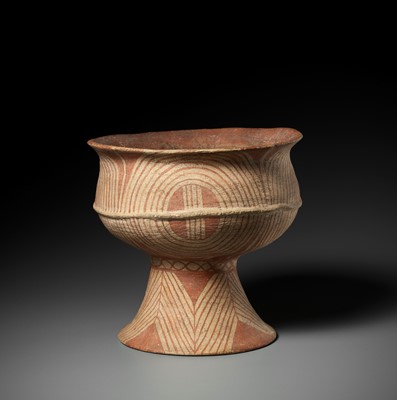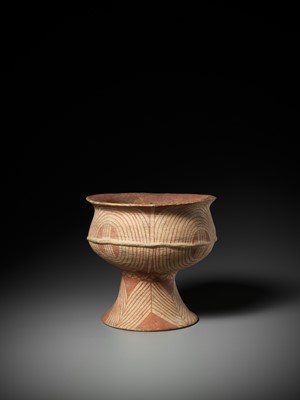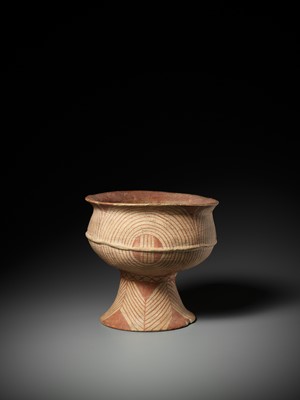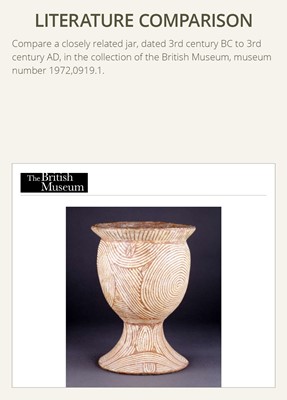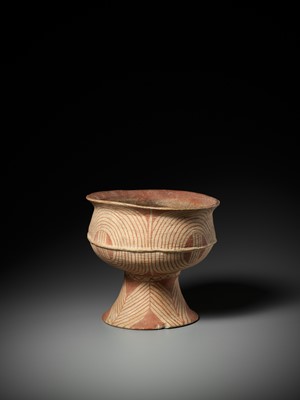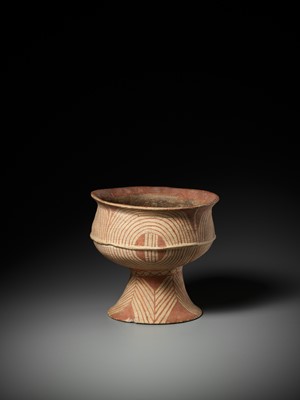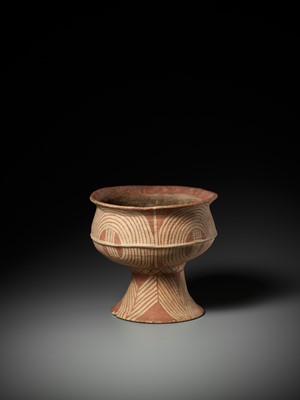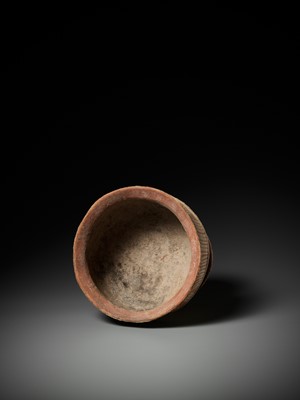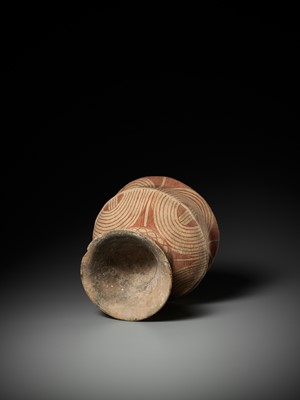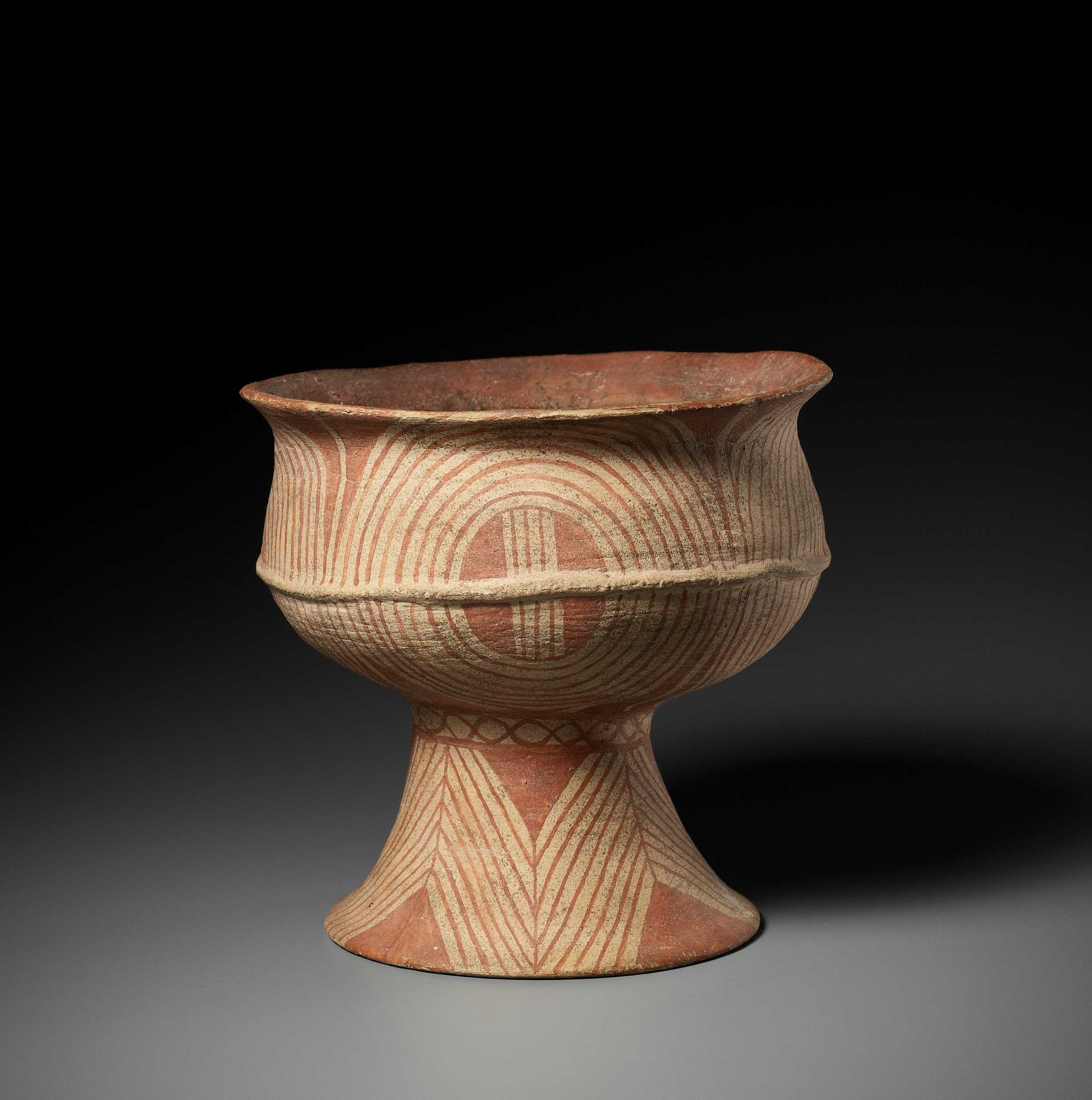30th Sep, 2022 10:00
DAY 2 - TWO-DAY AUCTION - Fine Chinese Art / 中國藝術集珍 / Buddhism & Hinduism
665
A PAINTED POTTERY STEM CUP, BAN CHIANG, 1ST MILLENNIUM BC
Sold for €1,040
including Buyer's Premium
The deep rounded sides supported on a tall spreading foot and rising to an everted rim, decorated with even red lines forming geometric designs on the creamy-white ware.
Provenance: Dutch trade.
Condition: Good condition, commensurate with age. Wear, signs of weathering and erosion, few chips, minor losses to the paint, no fills or restorations. A Ban Chiang piece in such well-preserved condition is considered to be rare.
Weight: 1,450 g
Dimensions: Height 18.9 cm
Ban Chiang, denotes an archeological site located in Nong Han district, Udon Thani Province, Thailand. Discovered in 1957, the site attracted enormous publicity due to its distinctive red painted pottery. During the first formal scientific excavation in 1967, archaeologists unearthed several skeletons, together with bronze grave gifts and unglazed earthenware pots which had been low-fired and painted red with unique, highly expressive and characteristic designs.
A subsequent excavation at Ban Chiang in 1974-1975 was followed by an article by Chester Gorman and Pisit Charoenwongsa, claiming evidence for the earliest dates in the world for bronze casting and iron working. Subsequent excavations, including that at Ban Non Wat, have now shown that the proposed early dates for Ban Chiang are unlikely. The first datings of the artifacts used the thermoluminescence technique, resulting in a range from 4420-3400 BC, which would have made the site the earliest Bronze Age culture in the world. These dates stirred worldwide interest. Thermoluminescence dating of pottery was at the time an experimental technique and had been applied to Ban Chiang sherds of uncertain provenance. However, with the 1974-1975 excavation, sufficient material became available for radiocarbon dating. Re-analysis by radiocarbon dating suggested that a more likely date for the earliest metallurgy at Ban Chiang was c. 2000-1700 BCE. A date of 2100 BCE was obtained from rice phytoliths taken from inside a vessel taken from the lowest grave, which had no metal remains. The youngest grave was about 200 CE. Bronze making began circa 2000 BCE, as evidenced by crucibles and other fragments. A contrasting analysis was conducted by Charles Higham of the University of Otago using the bones of the people who lived at Ban Chiang and the bones of animals interred with them. The resulting determinations were analyzed using Bayesian statistics and the results suggested that the initial settlement of Ban Chiang took place about 1500 BCE, with the transition to the Bronze Age about 1000 BCE. The chronology of Ban Chiang metallurgy is still in considerable dispute.
Literature comparison:
Compare a closely related jar, dated 3rd century BC to 3rd century AD, in the collection of the British Museum, museum number 1972,0919.1.
The deep rounded sides supported on a tall spreading foot and rising to an everted rim, decorated with even red lines forming geometric designs on the creamy-white ware.
Provenance: Dutch trade.
Condition: Good condition, commensurate with age. Wear, signs of weathering and erosion, few chips, minor losses to the paint, no fills or restorations. A Ban Chiang piece in such well-preserved condition is considered to be rare.
Weight: 1,450 g
Dimensions: Height 18.9 cm
Ban Chiang, denotes an archeological site located in Nong Han district, Udon Thani Province, Thailand. Discovered in 1957, the site attracted enormous publicity due to its distinctive red painted pottery. During the first formal scientific excavation in 1967, archaeologists unearthed several skeletons, together with bronze grave gifts and unglazed earthenware pots which had been low-fired and painted red with unique, highly expressive and characteristic designs.
A subsequent excavation at Ban Chiang in 1974-1975 was followed by an article by Chester Gorman and Pisit Charoenwongsa, claiming evidence for the earliest dates in the world for bronze casting and iron working. Subsequent excavations, including that at Ban Non Wat, have now shown that the proposed early dates for Ban Chiang are unlikely. The first datings of the artifacts used the thermoluminescence technique, resulting in a range from 4420-3400 BC, which would have made the site the earliest Bronze Age culture in the world. These dates stirred worldwide interest. Thermoluminescence dating of pottery was at the time an experimental technique and had been applied to Ban Chiang sherds of uncertain provenance. However, with the 1974-1975 excavation, sufficient material became available for radiocarbon dating. Re-analysis by radiocarbon dating suggested that a more likely date for the earliest metallurgy at Ban Chiang was c. 2000-1700 BCE. A date of 2100 BCE was obtained from rice phytoliths taken from inside a vessel taken from the lowest grave, which had no metal remains. The youngest grave was about 200 CE. Bronze making began circa 2000 BCE, as evidenced by crucibles and other fragments. A contrasting analysis was conducted by Charles Higham of the University of Otago using the bones of the people who lived at Ban Chiang and the bones of animals interred with them. The resulting determinations were analyzed using Bayesian statistics and the results suggested that the initial settlement of Ban Chiang took place about 1500 BCE, with the transition to the Bronze Age about 1000 BCE. The chronology of Ban Chiang metallurgy is still in considerable dispute.
Literature comparison:
Compare a closely related jar, dated 3rd century BC to 3rd century AD, in the collection of the British Museum, museum number 1972,0919.1.
Zacke Live Online Bidding
Our online bidding platform makes it easier than ever to bid in our auctions! When you bid through our website, you can take advantage of our premium buyer's terms without incurring any additional online bidding surcharges.
To bid live online, you'll need to create an online account. Once your account is created and your identity is verified, you can register to bid in an auction up to 12 hours before the auction begins.
Intended Spend and Bid Limits
When you register to bid in an online auction, you will need to share your intended maximum spending budget for the auction. We will then review your intended spend and set a bid limit for you. Once you have pre-registered for a live online auction, you can see your intended spend and bid limit by going to 'Account Settings' and clicking on 'Live Bidding Registrations'.
Your bid limit will be the maximum amount you can bid during the auction. Your bid limit is for the hammer price and is not affected by the buyer’s premium and VAT. For example, if you have a bid limit of €1,000 and place two winning bids for €300 and €200, then you will only be able to bid €500 for the rest of the auction. If you try to place a bid that is higher than €500, you will not be able to do so.
Online Absentee and Telephone Bids
You can now leave absentee and telephone bids on our website!
Absentee Bidding
Once you've created an account and your identity is verified, you can leave your absentee bid directly on the lot page. We will contact you when your bids have been confirmed.
Telephone Bidding
Once you've created an account and your identity is verified, you can leave telephone bids online. We will contact you when your bids have been confirmed.
Classic Absentee and Telephone Bidding Form
You can still submit absentee and telephone bids by email or fax if you prefer. Simply fill out the Absentee Bidding/Telephone bidding form and return it to us by email at office@zacke.at or by fax at +43 (1) 532 04 52 20. You can download the PDF from our Upcoming Auctions page.
How-To Guides
How to Create Your Personal Zacke Account
How to Register to Bid on Zacke Live
How to Leave Absentee Bids Online
How to Leave Telephone Bids Online
中文版本的操作指南
创建新账号
注册Zacke Live在线直播竞拍(免平台费)
缺席投标和电话投标
Third-Party Bidding
We partner with best-in-class third-party partners to make it easy for you to bid online in the channel of your choice. Please note that if you bid with one of our third-party online partners, then there will be a live bidding surcharge on top of your final purchase price. You can find all of our fees here. Here's a full list of our third-party partners:
- 51 Bid Live
- EpaiLive
- ArtFoxLive
- Invaluable
- LiveAuctioneers
- the-saleroom
- lot-tissimo
- Drouot
Please note that we place different auctions on different platforms. For example, in general, we only place Chinese art auctions on 51 Bid Live.
Bidding in Person
You must register to bid in person and will be assigned a paddle at the auction. Please contact us at office@zacke.at or +43 (1) 532 04 52 for the latest local health and safety guidelines.
